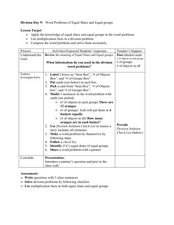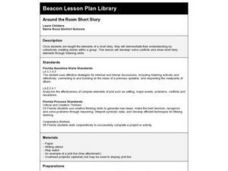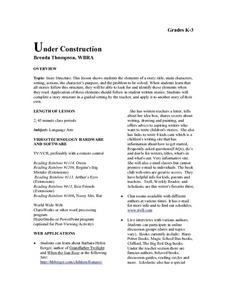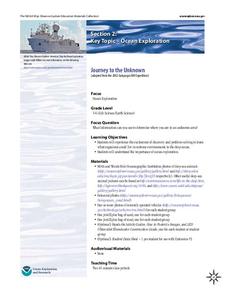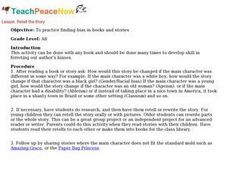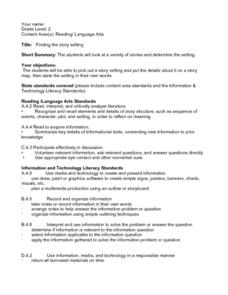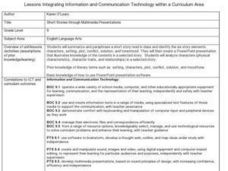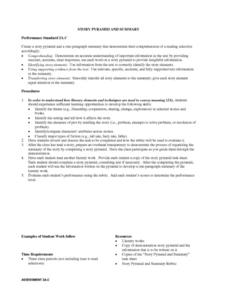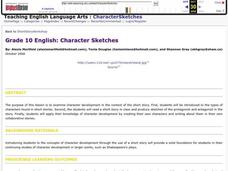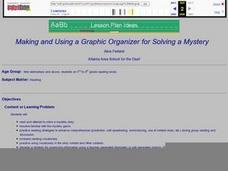Curated OER
Word Problems of Equal Share and Equal Groups
Explore this engaging approach to division problem solving with young scholars. They construct story problems after drawing 3 cards that give them a type of object, how many they have of that object, and the number of groups the object...
Curated OER
Around the Room Short Story
Collective story writing is a great way to reinforce the concept of story elements and collaborative learning. Young writers discuss story elements such as, setting, character, action, climax, conclusion, foreshadowing, dialogue, and...
Curated OER
Finding Problems In A Story
Students categorize information into a problem/solving chart and examine the value of using a diary. In this problem solving and diary lesson, students read portions of Dear Mr. Henshaw, while they investigate the importance of keeping a...
Curated OER
Under Construction
Young readers examine the elements of story structure that are included in all stories. They include these elements in their own written pieces. This phenomenally-designed plan has everything you need to easily implement it in your...
Curated OER
Number Stories
Students write and solve various number stories. They solve number stories using one, two and three digit numbers. Students practice writing sentences using the following 6+1 traits, ideas and content, organization, word choice and...
NOAA
Journey to the Unknown
What's it like to be a deep-sea explorer? Tap into the imaginations of your fifth and sixth graders with a vivid instructional activity, the second part of a six-part adventure. Learners close their eyes and submerge themselves in an...
Curated OER
The Rest of the Story
Third graders make predictions about the story "The True Story of the Three Little Pigs" based on background knowledge. They read the story, stopping to verify or reject predictions. They write their own opinionated fairytales.
Curated OER
Language and Dialect
Practice listening skills while studying oral story tellers from different parts of Louisiana. Consider the regional dialects and insider language of folk groups with your class. Identify language as part of folk life and recognize that...
Curated OER
Writing up Math in English
Seventh graders review the steps in writing a math problem. They write story problems stating the situation, the problem to be solved, explaining the process used to solve the problem, and state the answer. Students view a PowerPoint...
Curated OER
Retell the Story
Students identify bias in books. In this character education lesson, students read a text and discuss any gender or racial bias which may be present. Students retell and rewrite the story in a fair way.
Curated OER
Finding the Story Setting
Second graders discuss important things to know when reading stories, identify setting in variety of stories, create story map to record information as they are reading, state setting in their own words, discuss whether they thought...
Curated OER
The Gingerbread Story
Learners explore storytelling by reading a classic book. In this story structure lesson plan, students read the story The Gingerbread Man and identify the characters, settings and plot. Learners answer reading comprehension questions...
Curated OER
Short Stories Through Multimedia Presentations
Ninth graders summarize and paraphrase a short story read in class. They identify the six story elements of character, setting, plot, conflict, solution, and tone/mood. Students create a PowePoint presentation that illustrates the...
Curated OER
Story Pyramid and Summary
Students read a short selection of a story individually or as a class. On their own, they create a story pyramid for the selection and write a one page summary. They use text from the story for their supporting details. To end the...
Curated OER
Character Sketches
Learners are introduced to the types of characters found in short stories. They read a short story in class and produce sketches of the protagonist and antagonist. Finally, they create their own characters and write about them in their...
Curated OER
Evaluate Problem-Solving in the Context of Culture and Time-frame
Pupils examine literary elements in non-fiction literature. In this problem solving lesson, students read Rosa Parks, My Story and Beyond the Limits. Pupils make oral presentations based on the causes and effects, conflicts, and problem...
Curated OER
Author's Corner
Second graders read a picture book at a Web site about a bunny who solves a problem and becomes friends with a squirrel. Students then discuss story with classmates, brainstorm ideas for their own stories about friendship, and read the...
Curated OER
Making and Using a Graphic Organizer for Solving a Mystery
Students create tables in a word processing program which helps them organize their text clues when reading a mystery story. They develop reading comprehension strategies while using a computer based graphic organizer in order to solve...
Curated OER
Fairy Tale Math
Have class members rewrite a favorite fairy tale in order to incorporate numerical information. For inspiration, the teacher provides an example written by another second grader. These modified stories are then used to write word...
Curated OER
Retell the "Tail" of the Tale
Students explore story structure. In this multicultural literacy activity, students discuss common elements of folk tales and then listen to the story Tiger and the Big Wind: A Tale from Africa. Students identify the problem and solution...
Curated OER
Hatchet
Students write about a time when they were in a situation where nature frightened them. They write about how Brian solved the problem of how to start a fire in the story. Students complete a short research paper on one of the plants or...
Curated OER
Don't Flick Your Bic!
Students research the ban on lighters in the airport and how it is being enforced. Individually, they create and conduct a survey on family members who smoke about this issue. Using the internet, they discover what airports are doing to...
Curated OER
$250 Cookie Recipe
Students practice solving story problems based on cookies. They are read the background information about the cookie story and then complete a worksheet. They also wrtie a response to what they would have done had the story happened to...
